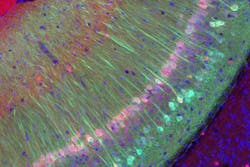Optogenetics helps identify neurons devoted to social memory
A team of neuroscientists at the RIKEN-MIT Center for Neural Circuit Genetics at the Picower Institute for Learning and Memory (Cambridge, MA) has discovered that mice have neurons that are dedicated to storing memories of other mice. These cells, found in a region of the hippocampus known as the ventral CA1, store social memories that help shape the mice's behavior toward each other.
Related: Light triggering demonstrates that memory engrams are physical phenomena
The researchers also showed that they can suppress or stimulate these memories by using optogenetics to manipulate the cells that carry these memory traces (engrams). "You can change the perception and the behavior of the test mouse by either inhibiting or activating the ventral CA1 cells," says Susumu Tonegawa, the Picower Professor of Biology and Neuroscience and director of the RIKEN-MIT Center for Neural Circuit Genetics, and the senior author of the paper describing the work.
Many of these cells were found in and around the hippocampus, which is also where the brain stores memories of events, known as episodic memories. The team suspected that in mice, social memories may be stored in the hippocampus' ventral CA1, in part because previous studies have suggested that this region is not involved in storing episodic memories.
The researchers set out to test this hypothesis using optogenetics: By engineering neurons of the ventral CA1 to express light-sensitive proteins, they could artificially activate or inhibit these cells by shining light on them as the mice interacted with each other. First, the researchers allowed one mouse, known as the test mouse, to spend time with another mouse for two hours, letting the mice become familiar with each other. Soon after, the test mouse was placed in a cage with the familiar mouse and a new mouse.
Under normal circumstances, mice prefer to interact with mice they haven't seen before. However, when the researchers used light to shut off a circuit that connects the ventral CA1 to another part of the brain called the nucleus accumbens, the test mouse interacted with both of the other mice equally, because its memory of the familiar mouse was blocked.
"The inhibition of ventral CA1 leads to impairment of the social memory," says MIT postdoc Teruhiro Okuyama, the paper's lead author. "They cannot show any preference for the novel mouse. They approach both mice equally."
On the other hand, when the researchers stimulated ventral CA1 cells while the test mouse was interacting with a novel mouse, the test mouse began to treat the novel mouse as if they were already acquainted. This effect was specific to social interactions: Interfering with the ventral CA1 did not have any effect on the mice's ability to recognize objects or locations that they had previously seen.
When the researchers monitored activity of neurons in the ventral CA1, they found that after a mouse was familiarized with another mouse, a certain population of these neurons began to respond specifically to the familiar mouse. These patterns could be seen even after the mice appeared to forget the once-familiar mice. After about 24 hours of separation, the test mice began to treat their former acquaintances as strangers, but the neurons that had been tuned to the familiar mice still fired, although not as frequently. This suggests that the memories are still being stored even though the test mice no longer appear to remember the mice they once knew.
Furthermore, the researchers were able to re-awaken these memories using optogenetics. In one experiment, when the test mouse first interacted with another mouse, the researchers used a light-sensitive protein called channelrhodopsin to tag only the ventral CA1 cells that were turned on by the familiarization treatment. When these neurons were re-activated with light 24 hours later, the memory of the once-familiar mouse returned. The researchers were also able to artificially link the memory of the familiar mouse with a positive or negative emotion.
Tonegawa's lab has previously used this technique to identify hippocampal cells that store engrams representing episodic memories. The new study offers strong evidence that memory traces for specific individuals are being stored in the neurons of the ventral CA1, Tonegawa says. "There is some kind of persistent change that takes place in those cells as long as memory is still detectable," he says.
The researchers are now investigating a possible link between social memory and autism. Some people with autism have a mutation of the receptor for a hormone called oxytocin, which is abundant on the surface of ventral CA1 cells. Tonegawa's lab hopes to uncover whether these mutations might impair social interactions.
Full details of the work appear in the journal Science; for more information, please visit http://dx.doi.org/10.1126/science.aaf7003.

